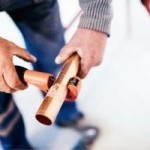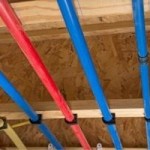What Are Repiping Services?
As a home ages, certain problems can arise from the materials used during construction. Even with the most durable materials, there is a life expectancy, after which it is reasonable to expect problems and plan for replacement.
Residential plumbing is one such case where aging materials can begin to fail and cause problems. This is especially the case when homes are plumbed with steel pipes. The truth is, steel pipes are nearing the end of their expected service life. Building codes were changed in the 1960s that encouraged the use of copper piping. Fortunately, plumbers can repipe an entire home with upgraded materials with life expectancies around 100 years.
If a home has frequent clogs, leaks, pipe bursts, and fluctuations in water pressure, it may be time to consider repiping.
Differences Between Copper and PEX Piping

Halfway through the last century, copper was cheap and became the material of choice for plumbing. Copper piping is rigid and fitted together with coupling and elbows that are soldered into place. In most areas, copper is still preferred for hot water lines because of its thermal properties.
PEX is a modern plastic piping alternative to metal pipes that are refined from petroleum products. PEX is cheap and easy to install. There are several different types of fittings that are used for PEX depending on the preferences of the plumber installing it. PEX has become the material of choice for most plumbing installations.
Opting for PEX Piping

PEX piping has some drawbacks and benefits. As for the benefits, PEX is one of the cheapest options available, and it is easy to install, so it saves money on labor costs too. PEX is resistant to corrosion, so it is less likely to spring leaks over the next 100 years of service. Due to its flexibility, PEX is somewhat resistant to freezing damage, although a hard freeze can rupture it.
As for drawbacks, PEX is made from non-renewable resources. Like most plastics, PEX can be damaged by UV rays in sunlight. It has poor heat transfer qualities, so insulation is recommended. Since it’s plastic-based, it can allow organic solvents to seep through into a home’s water supply.
Pros and Cons of Copper Piping

There are reasons that copper piping has been the material of choice for so long. Copper pipes are expected to last up to 100 years, after which time they are recyclable. Copper pipes are durable and not prone to abrasion. For external installations, copper is preferred because it is resistant to UV light. Hot water lines are still usually run in copper because it causes less temperature fluctuation than alternatives.
The downside of copper is that it is expensive to install, and the methods are more labor-intensive. If installed improperly, copper can fall victim to corrosion.
About Swick Home Services
Swick Home Services has been helping Marquette homeowners with expert repiping services since 1977. Contact them today to see how their Gold Star Membership services protect local homes.













